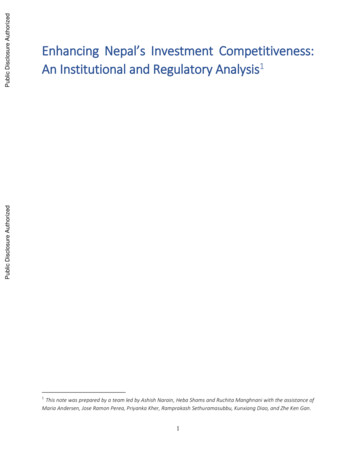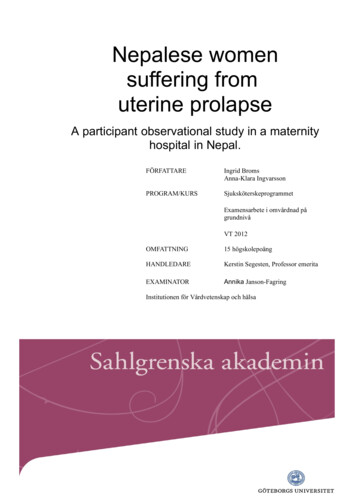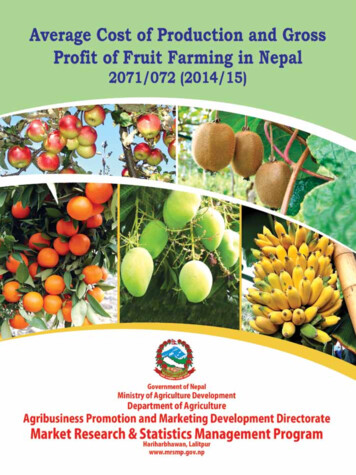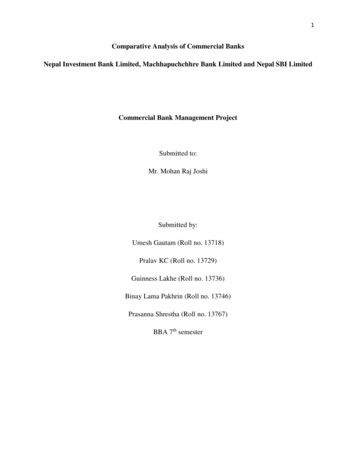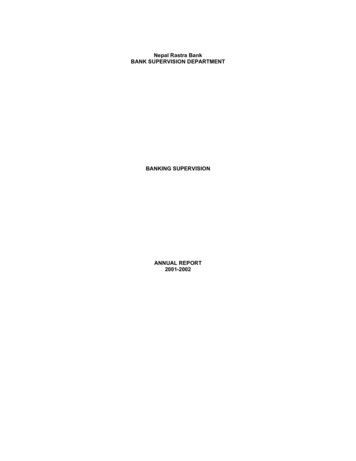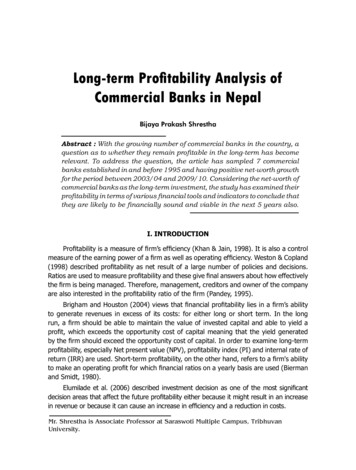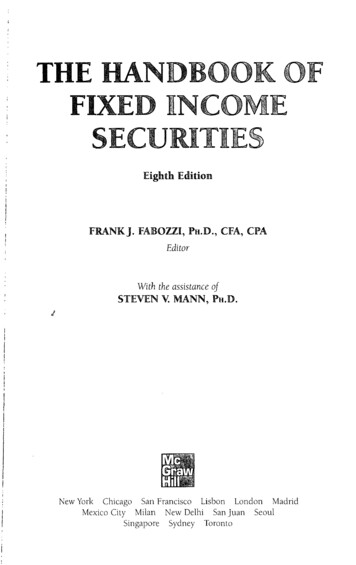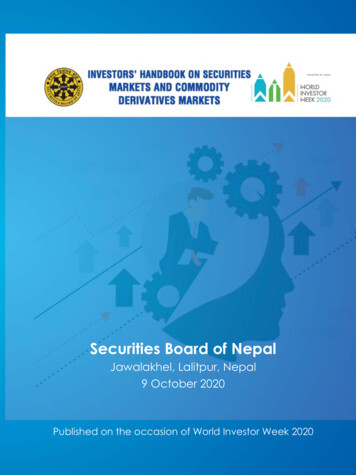
Transcription
Securities Board of NepalJawalakhel, Lalitpur, Nepal9 October 2020Published on the occasion of World Investor Week 2020
INVESTORS’ HANDBOOKON SECURITIES MARKETS AND COMMODITYDERIVATIVES MARKETSSecurities Board of Nepal (SEBON)Jawalakhel, Lalitpur, Nepal9 October 2020Published on the occasion of World Investor Week 2020
Investors’ HandbookIII
Investors’ HandbookEditorialThe Nepalese securities markets is beingmodernised due to some structuralchanges in the recent years. The fullfledged dematerialised transactionof securities, the introduction of ASBA,C-ASBA and Meroshare system inthe primary market enabling theapplicants from 77 districts to accessthe service through more than 2500BFIs as service providers, branchexpansion of merchant bankers andstockbrokers outside of Kathmanduvalley and adoption of on-line tradingsystem have made Nepalese securitiesmarkets techno-friendly, investmentfriendly and countrywide resultingincreased attraction of public towardsthe securities markets in recent days.Low level of participation of institutionalinvestors in the markets, lack ofdiversified instruments and low levelof understanding and awareness insecurities markets continues to bea cause of concern. Investors andeven students tend to use thumb rulesor seek advice from friends, marketintermediaries and relatives, which areoften poor approximations comparedto those that follow from a scientificanalysis. They will tend to make badchoices, contribute insufficiently, beginsaving late, stay away from modernfinance, or fall prey to fraud or mis-sellingof financial instruments. If they get badadvice, the outcomes will be poor, andthey will lose faith in the market system.Taking note of aforementioned facts,Securities Board of Nepal (SEBON) hasbeen focusing on the investor educationand awareness building programmein securities markets and commodityderivatives markets in order to empowerand protect the interest of generalinvestors at large. As a continuation ofthis, World Investor Week (WIW) 2020Organising Committee is pleased tobring out “Investors’ Handbook onSecurities Markets and CommodityDerivatives Markets”. The purpose ofthe handbook is to provide the basicsof securities markets and commodityderivatives markets to the students ofSchools and Colleges at early age andinvestors at large to enable enhancingtheir understanding and makinginformed investment decisions of theirhard-earned incomes and savings.The Handbook is a compilation ofthe basic information about financialmarkets, securities markets, commodityderivatives markets, SEBON and itsfunctions, IPO process, shareholders’rights, primary and secondary markets,investmentinstruments,servicesprovided market participants, mostuseful terms of the markets, and tips forinvestment.We request students and investors touse this handbook as guidance forunderstanding of securities markets andmaking better investment decision.We would like to thank the Chairman ofSEBON and Management of SEBON forproviding us the opportunity in bringingout this publication.We are alsothankful for entrusting us with the task oforganising the WIW 2020.Finally,wewelcomevaluablecomments and suggestions in makingthis publication more useful andeffective in the future.V
Investors’ HandbookWIW 2020 Organising CommitteeDr Nabaraj Adhikari, Deputy Executive Director and CoordinatorDeepa Dahal, Deputy Executive Director and MemberAnuj Kumar Rimal, Acting Director and MemberYam Nath Aryal, Assistant Director and MemberSanu Khadka, Assistant Director and Member (Invitee Member)VI
Investors’ HandbookABBREVIATIONSSEBONSecurities Board of NepalRIIRetail Individual InvestorAMCAsset ManagementCompanySROSelf Regulatory OrganisationSBANStockbroker Association ofNepalCGTCapital Gain TaxSTTSecurities Transaction TaxMBANMerchant BankerAssociation of NepalUCCUnique Client CodeUINNEPSENepal Stock Exchange Ltd.Unique IdentificationNumberBTIBanker to the IssueVCFVenture Capital FundBOBeneficiary OwnerDMATNOTSNEPSE Online Trading SystemLtd.Dematerialisation (ofsecurities)CBICentral Bureau ofInvestigationCDSCCDS and Clearing Ltd.(Central Depository Services)CISCollective InvestmentSchemeIPFInvestor Protection FundDPDepository ParticipantFAQsFrequently Asked QuestionsF&OFutures and OptionsGoNGovernment of NepalICANWIW World Investors WeekDIS Debit Instruction SlipSASRF South Asian SecuritiesRegulators ForumANNAAssociations of NationalNumbering AgenciesAFIEAsia Forum for InvestorEducationOECDOrganisation for EconomicCooperation andDevelopmentAPECAsia-Pacific EconomicCooperationInstitute of CharteredAccountants of NepalUS SECUnited States Securities andExchange CommissionIPOInitial Public OfferingASICISINInternational SecuritiesIdentification NumberAustralian Securities &Investment CommissionSEBIKIMKey InformationMemorandumSecurities and ExchangeBoard of IndiaFSAMBsMerchant BankersFinancial Services Agency,JapanMFsMutual FundsOJKNAVNet Asset ValueOtoritas Jasa Keuangan,IndonesiaPSUPublic Sector UndertakingQIBQualified Institutional BuyerVII
Investors’ HandbookTable of ContentsContentsPage No.Message from the ChairmaniiiEditorialvAbbreviationsviiTable of ContentsxiChapter 1An Introduction to Financial Markets1Money Markets1Capital Markets1Securities Markets1Primary market2Secondary market2Desirable Characteristic of Financial Markets2Market Efficiency2Market Depth3Market Width3Undesirable Activities of the Markets3Market Cornering3Wash Sales4Churning4Pump-and-Dump4Financial Market Styles4Order Driven Markets4Quote Driven Markets4Principal and Agency Trading5Financial System5Overview of Nepalese Financial System5Bank and Financial Institutions6Securities Markets6Insurance Sector7The Non-Banking Financial Intermediaries (NBFIs)7Cooperatives7IX
Investors’ HandbookChapter 2Introduction to Securities Markets and Commodity DerivativesMarkets8Securities Markets8Role of Securities Markets9Risk Associated with the Securities Markets9Systematic Risk9Market Risk10Industry Risk10Business Risk10Regulatory Risk10Historical Development of Securities Markets10Development of Securities Market in Nepal10Commodity Derivatives Markets11Types of Commodity Markets12Basis of Nepalese Commodity Derivatives Market Operation13Adoption of Risk Reduction Mechanism13Objectives of Commodity Derivatives Market Regulation13Chapter 3Introduction to Securities Board of Nepal (SEBON)14Major Function, Duties and Power of SEBON14Legal Framework16Objectives of Securities Laws of Nepal16International Relations of SEBON16CHAPTER 4Public Issue of Securities17An introduction of Public Issue17XInitial Public Offering (IPO)17Further Public Offering (FPO)17Rights Issue18Private Placement18
Investors’ HandbookBonus Share Issue19Public Issue Process19In case of Right20SEBON’s Role in Public Issue of Securities21CHAPTER 5Financial Instruments22Money Market Instruments22Securities Markets Instruments22Common Types of Securities23Shares23Bonds/Debenture23Categories of Bond24The Risk Faced by Investors in Bond24Interest Rate Risk24Inflation risk24Liquidity Risk25Default Risk25Mutual Funds25Derivatives25Hybrid Instruments25Specialised Investment Fund (SIF)26Private Equity (PE)26Venture Capital (VC)26Hedge Funds (HF)26CHAPTER 6Investment Planning & Process28Determining Steps to Investing28Importance of Investment28Investment Objectives28Specification of the Financial Goals29Assessing the Financial Capacity29Investment Process30XI
Investors’ HandbookLevel and Management of Risk31Process of Investment33Purchasing Process33Chapter 7Right of Shareholders35Major rights of shareholders entrusted by SecuritiesRelated Act, 2006 and Company Act, 200635Chapter 8Market Participants: Nepal Stock Exchange Ltd.An Introduction to NEPSETrading Sessions in NEPSEPrice RangeOrder MatchingTrade Management System for Brokers and ClientsInvest as an Informed InvestorMarket Index/IndicesBasis of Indices/IndexIn a Price WeightingIn a Value WeightedAn Equal WeightingCalculation of NEPSE IndexSensitive IndexFloat IndexCircuit Breaker and Trading HaltClassification of Listed Companies by NEPSE3838383838393939404040404040414141Market Participants: Depository ServicesAn Introduction to the Depository SystemService Offered by CDSCParties Involved with CDSC42424343The Purpose of Opening a Demat Account43Dematerialisation (Demat) & Rematerialisation (Remat)43Beneficial Owner (BO)43Depository Participant (DP)44An Issuer44Registrar and Transfer Agent (RTA)44International Securities Identification Number (ISIN)44XII
Investors’ HandbookBeneficial Owner Identification Number (BOID)44Services Rendered by a DP to the Investors44Software used by CDSC for the Depository System45Mechanism of Data Security in the System45Benefits of opening a demat account for investorsMarket Participants: Merchant BankersHistory of Merchant BankingFunctions and Services Offered by Merchant BankerCapital StructuringProject Evaluation and Due DiligenceLegal AspectsPricing of the IssuePreparing of Prospectus and Offer DocumentsMarketing of the IssueArrangement of Collection Center and Collection of ApplicationResponsibilities of Merchant Banker to the InvestorsMarket Participants: StockbrokerConsideration Required while Selecting StockbrokersResponsibilities of a StockbrokerDetails an Investor Need to Submit to BrokerUnique Client CodeBrokerage Charge/CommissionCapital Gain Tax (CGT)Market Participants: CRA for Credit Rating ServicesCredit Rating Service and IPO GradingCredit Rating History in NepalGrading of Public 1Chapter 9Investor EducationObjectives of Investor Education ProgrammeInvestor Education in NepalSEBON Initiatives Towards Empowering General InvestorsHandling Investors’ Grievances5252525253XIII
Investors’ HandbookChapter 1016 Mantras for Wise Investment54Chapter 11DO’S & DON’TS:58DO’S & DON’TS: Primary Market58DO’S & DON’TS: Secondary Market58DO’S & DON’TS: Dealing with Stockbrokers60Chapter 12Frequently Asked Questions (FAQ)61FAQ: Primary Market61FAQ : Secondary Market64FAQ: Mutual Fund (MF) and CIS67FAQ: Depository & DP Services68FAQ: Derivative Markets79Chapter 13Most Useful Terms of the Markets87Annexures106Annexure 1. List of Securities Acts, Regulations, Directives, Byelaws 107Annexure 2. List of Stockbrokers108Annexure 3. List of Merchant Bankers111Annexure 4. List of Related Websites114XIV
Investors’ HandbookChapter 1An Introduction to Financial MarketsFinancial markets is a marketplace,where creation and trading of financialassets like shares, debentures, bonds,derivatives, currencies and so forthtakes place. It plays very important rolein allocating scarce resources in theeconomy of the country. The financialmarkets can be broadly classified into (i)money markets and (ii) capital marketsas in figure 1.Figure 1Money MarketsMoney markets is a market for debtsecurities that pay off in the short-termusually less than one year, for instance,the market for 90-days treasury bills.This market encompasses the issuanceand trading of short-term non-equitydebt instruments including treasurybills, commercial papers, bankers’acceptance, certificates of deposits,etc.Capital MarketsCapital markets is a market for long-termdebt and equity shares usually for morethan one year. In this market, the capitalfunds comprising both equity and debt,are issued and traded. This includesboth private placement sources of debtand equity as well as organised marketslike stock exchanges.Securities MarketsIt is composed of two terms “Securities”and “Markets” referring financialinstruments issued to raise funds anda place or places where securitiesare bought and sold respectively. Itprovides facilities and people engagedin such transactions, the demand forand availability of securities to betraded, and the willingness of buyersand sellers to reach agreement on sales.Secondary markets include over-thecounter markets and stock exchange.The primary function of the securitiesmarkets is to enable to flow of capitalfrom those that have it to those thatneed it. Securities market helps intransfer of resources from those withidle resources to others who have aproductive need for them. Securitiesmarkets provide channels for allocationof savings to investments and therebydecouple these two activities. As aresult, the savers and investors are notconstrained by their individual abilities,but by the economy’s abilities to investand save respectively, which inevitablyenhances savings and investment in theeconomy.1
Investors’ HandbookSecurities markets can be furtherdivided into the (i) primary market and(ii) secondary market.Primary MarketA market where securities are directlyoffered to the general public by acompany or issuer with the help ofmerchant bank as an intermediary whoacts as an expert of issue managementon behalf of the issuer. The issuemanagement is done by issue managerunder merchant banking functionlicensed by the Securities Board ofNepal (SEBON).Secondary MarketA market where securities, both equityand debt, are traded after beinginitially offered to the public in theprimary market and listed at the stockexchanges. Trading of listed securitiestake place in the secondary market.For a company, secondary equitymarkets serve as a monitoring andcontrolconduit—byfacilitatingvalue-enhancing control activities,enabling implementation of incentivebased management contracts, andaggregating information (via pricediscovery) that guides the managementdecisions. For an investor, the secondarymarket provides an efficient platformfor trading as well as liquidity of hisinvestment made in securities.Over the counter market is one ofsegments of secondary market. Nonlisted along with delisted securities ofpublic limited companies can be tradedon OTC market platform providedby the NEPSE normally without theinvolvement of market intermediaries. Itis off-exchange trading of shares.2Desirable Characteristic of FinancialMarkets(i) Market efficiency, (ii) Market depth,and (iii) Market width are prerequisiteof financial market. These factors arethe desirable characteristics of financialmarket.Market EfficiencyThe primary market provides anintermediary function by channelingfunds from investors (with savings) tofirms and businesses that are seekingfunds for investments. Secondarymarkets, on the other hand, reinforcethe primary market by providing theflexibility for investors to liquidate theirholdings when desired.Financial markets also perform anallocative function, by directing investorsavings to business and investments withthe highest returns. Firms and businessesthat are efficiently operated and areable to identify superior investmentopportunities will command higherprices for their securities and will attractthe needed capital. Resources thus willflow to the best uses in the economy.However, this depends on whetherthe market is efficient, in the sense thatwhether stock prices accurately reflectthe expectations about companies’performance. Markets are usuallyclassified under one of three levels ofefficiency; (i) weak, (ii) semi strong and(iii) strong.In the weak form efficient market,stock prices are assumed to reflect allpast information including price andvolume information which means thatabnormal profits cannot be mode oftrading based on historical information.
Investors’ HandbookThe market reflects all publicly availableinformation in the semi strong formefficient markets, while reflecting allinformation whether public or nonpublicin security prices. In the semi strong form,investors cannot make abnormal profitsusing publicly available information,and not even inside information if themarket is efficient at the strong fromlevel.In addition to efficiency, liquidity isanother desirable property in a market.Liquidity enables an investor to sella security quickly and easily at a fairprice. Money market securities such asgovernment treasury bills tend to bevery liquid, while real estate assets aretypically illiquid. Market participants arewilling to pay a premium for securitiesthat are liquid and inflict a discount onsecurities that are illiquid. The liquidity ofa security is particularly affected by (i)market depth and (ii) market width.Market DepthThe market for a security is said to havedepth, if there are plenty of buy ordersand sell orders within a narrow rangearound the current market price. In adeep market, the existence of manyorders means that the price of thesecurity is quickly brought to equilibriumas the demand and supply for thatsecurity changes. In contrast, shallowmarkets are characterised by shortagesor oversupply resulting in discontinuityof buy and sell orders and large pricejumps. If supply exceeds demandthe price of the security declines by alarge amount that may cause materiallosses to holders of the security, whichmay force them to postpone selling thesecurity. On the other hand, if demandexceeds supply, prices rise to sucha degree that potential buyers maypostpone the purchase of the security.Market WidthThe market for a security is said to havewidth or broad, if it is characterisedby large transaction volumes. In suchmarkets, not only prices are able tochange continuously because of theexistence of lots of orders (as in a deepmarket), but the order sizes above andbelow the current market price are alsolarge. As a result, there is no incentivefor buyers or sellers to postpone theirdecisions. Market makers are willing toaccept smaller margins (spread) as thehigh turnover volume compensates forthe small margins.Undesirable Activities of the MarketsDeveloped capital markets needproper regulations in place to preventundesirable activities that distorts theefficiency of the market are (i) Marketcornering (ii) Wash Sales, (iii) Churning,and (iv) Pump-and-DumpMarket CorneringThis happens when a person buys allor most of the available quantities ofa certain security, to create a form ofmonopoly that may later enable him tosell the security at a higher price, he issaid to be cornering the market. Marketregulation generally prohibits suchactivity3
Investors’ HandbookWash SalesIt means to create an illusion of tradingactivity for a given stock. One formof wash sale is when a person sells asecurity to his son or a family memberand then buys back the same securityon the same day at either at higherprice or lower price, depending onthe illusion that the person is intendingto create. The primary motive of suchactions is to mislead the market in orderto make unethical profits.A deceptive investor could use thistechnique to artificially raise the priceof a security by selling the stock at ahigh price and buying it back at a lowerprice on the same day. Encouragedby this false impression of false tradingactivity other investors enter the marketas buyers resulting in a further rise in thesecurity’s market price. This allows thedeceptive investor to sell his holdings atthese artificially higher pricesChurningChurning happens from a stockerbroker’s part. It takes place whena broker engages in frequent andunnecessary trading on behalf of theclient. This is done by some unscrupulousbrokerstogenerateincreasedincome from trading commissions. It isconsidered unethical and is an illegalactivityPump-and-DumpPump-and-dump is a scheme thatattempts to boost the price of a stockthrough recommendations based onfalse, misleading or greatly exaggerated4statements. The perpetrators of thisscheme already have an establishedposition in the company’s stock andsell their positions after the hype has ledto a higher share price. This practice isillegal based on securities law and canlead to heavy fines.Financial Market StylesFinancial markets can operate ondifferent basis or styles. The major basisare (i) Order Driven and (ii) Quote DrivenMarket.Order Driven MarketsIn an order driven market, potentialbuyers and sellers of securities indicatehow many securities they want to buyor sell and at what price. The tradingsystem brings buyers and sellers togetherwhere their requirements match. Mostof the major stock markets around theworld operate form of order driventrading system, such as the New YorkStock Exchange and the London StockExchange and Nepal Stock ExchangeLtd.Quote Driven MarketsA small number of stock exchanges alsooperate under a quote driven style. Ina quote driven style, the exchangeenables financial institutions to act asmarket makers. Market makers areobliged to provide two-way quotesto buy and sell particular securitiesthroughout the standard market hours.In order to generate profit, the marketmaker will quote a lower price to buythe securities (the bid price), and ahigher price to sell the securities (the
Investors’ Handbookoffer ask price). The difference betweenthe prices is often referred to as the bidoffer ask spread. The key advantagethat the quote driven system offers overthe order driven system is the ability totrade throughout the trading day. This isbecause the market makers are obligedto quote prices and be able to trade in atleast a set minimum number of securities.In an order driven market, liquiditycould dry up, if there are no orders tobuy (or to sell). The disadvantage of thequote driven system is that investors areeffectively paying for the provision ofliquidity through the bid-offer spread,compared to the order driven systemwhere the orders are matched.Principal and Agency TradingIn both the order driven and quotedriven market styles, firms can act in twocapacities – (i) agent or (ii) principal. Afirm acting as agent simply arranges thetrade on behalf of the client, charginga commission. Firms acting as principalactually buy or sell securities themselves,such as market makers in quote drivenmarkets. Clearly, firms taking principalpositions take greater risks than thoseacting as in an agency capacity.Financial SystemIn a simple, a financial system allows theexchange of funds between differentfinancial market participants likelenders, investors, and borrowers. Thesystems operate at national and globallevels and consisting of complex, closelyrelated services, markets, and institutionsintended to provide an efficient andregular linkage between investors anddepositors.According to OECD a financial systemconsists of institutional units and marketsthat interact, typically in a complexmanner, for the purpose of mobilisingfunds for investment, and providingfacilities, including payment systems, forthe financing of commercial activity.1The financial system is composed ofthe products and services providedby financial institutions, which includesbanks, insurance companies, pensionfunds, organised exchanges, and themany other companies that serveto facilitate economic transactions.Virtually all economic transactionsare effected by one or more of thesefinancial institutions. They createfinancial instruments, such as stocksand bonds, pay interest on deposits,lend money to creditworthy borrowers,and create and maintain the paymentsystems of modern economies.Overview of Nepalese FinancialSystemThefinancialsystemenableslenders and borrowers to exchangefunds. Nepal has a financial system thatis controlled and regulated by separateindependent regulators in the sectorsof insurance, banking (money market),1.Glossary of statistical terms-OECD5
Investors’ Handbookcapital markets, cooperative and other services sectors. Nepalese financial systemas at 30 August 2020 is in the figure 2.Figure 2Under the financial system of Nepal,there are five sub-systems namely bankand financial institutions (BFIs), securitiesmarkets, insurance companies, nonbanking financial institutions and cooperatives. Each sector is the subsystem of the financial system since theactivities in one sub-system affects notonly another sub-system but can affectthe entire financial system.Bank and Financial InstitutionsAs of 30 August 2020, there are a total of27 commercial banks, 20 developmentbanks, 22 finance companies, 85microfinance companies, and oneinfrastructure development bank. BFIsare regulated by Nepal Rastra Bank(NRB), the-central bank of Nepal with6the provisions under .BFIs Act, 2017 andNepal Rastra Bank Act, 2002.Securities MarketsIt consists of different market participantsand their interactions such as (i) stockexchange (NEPSE), (ii) listed companies,(iii) stockbrokers, (iv) merchant bankers,(v) central depository company (CDSC),(vi) depository participants (DPs), (vii)clearing members, (viii) ASBA members,(ix) credit rating companies and so forth.Securities Board of Nepal (SEBON) is theregulatory authority of the securitiesmarkets in Nepal. Securities Markets isregulated under the Securities RelatedAct, 2006.
Investors’ HandbookInsurance SectorInsurance sector consists of life, non-lifeand reinsurance companies and theirinteractions. The objectives of insurancesector regulation is to systematise,regularise, and develop the insurancebusiness in Nepal. Insurance Board isthe regulatory authority of insurancesector in Nepal. It regulates insurancecompanies with the provisions under theInsurance Act, 1992.The Non-Banking FinancialIntermediaries (NBFIs)Theyarejustintermediariesormiddlemen transferring funds fromultimate lenders to ultimate borrowers.The financial intermediaries obtainfunds by issuing to the public their ownliabilities such as saving deposits andloan shares and then use this moneyto buy financial assets namely stocks,bonds and mortgages for themselves.In this way the financial intermediariesintermediate between original saversand final borrowers”.Non-banking financial institutions, inNepal, consist of Employees ProvidedFund (EPF), Citizen Investment Trust (CIT),Deposit and Credit Guarantee Fund andSocial Security Fund. The EPF and CITestablished under special Acts, operateunder the supervision of Government ofNepal, Ministry of Finance (MoF).economic, social, and cultural needsand aspirations through a jointlyowned and democratically-controlledenterprise ”. Cooperatives may include(i) non-profit community organisations,(ii) businesses owned and managedby the people who use their services (aconsumer cooperative) (ii) organisationsmanaged by the people who workthere(workercooperatives),(iii)organisations managed by the peopleto whom they provide accommodation(housing cooperatives), (iv) hybrids suchas worker cooperatives that are alsoconsumer cooperatives or credit unions,(v) multi-stakeholder cooperatives suchas those that bring together civil societyand local actors to deliver communityneeds, (vi) second and third-tiercooperatives whose members are tant role in the financial systems ofthe country. They act as a safe haven fordeposits and are major sources of creditfor households and small- and mediumsized firms. In Nepal, co-operatives areregulated by the Department of Cooperatives under the Cooperative Act,2017.CooperativesA cooperative also called as cooperative, co-op, or coop is “anautonomous association of personsunited voluntarily to meet their common7
Investors’ HandbookChapter 2Introduction to Securities Marketsand Commodity Derivatives MarketsSecurities MarketsSecurities markets is a market forsecurities (equity, debt and unit), wherebusiness enterprises (companies) andGovernments can raise long-termfunds for the initiation and expansionof business. It is defined as a market inwhich money is provided for periodslonger than a year (raising of short-termfunds takes place on other marketslike the money market). Financialregulators, such as SEBON regulatesand oversee the securities markets inits designated jurisdictions to ensure anorderly development of the marketsand protection of investors.Securities markets normally imply anyexchange marketplace where financialassets and securities are traded. Socapital markets is a broader term in thesense that it includes trading of bonds,derivatives, and commodities as well assecurities or stocks. On the other hand,share/stock markets can be taken asa category of capital markets wheresecurities/stocks are traded. These twoterms have been used interchangeably.Securities market development isessential for the economic developmentof a country. The objective of economicactivity in any country is to promotethe well-being and standard of livingof its people, which depends uponthe distribution of income in terms ofgoods and services in the economy.For the growth process in the economy,8production plays a vital role. Productionof output depends upon materialinputs, human inputs, and financialinputs. Material inputs are in the formof raw materials; plant, and machinery,etc., Human inputs are in the form ofintellectual, managerial and labourmanpower. Financial inputs are in theshape of capital, cash, credit etc. Theproper availability and utilisation ofthese inputs promotes the economicdevelopment of a country.The financial inputs, among othersources, emanate from the securitiesmarket system. The securities marketthrives with investors’ confidence basedupon their return on investment as well asfrom anticipated capital appreciationfrom their investment.Investors are a heterogeneous group;they comprise wealthy and middleclass, educated and illiterate, youngand old, expert, professional and nonprofessional and lay-man. However, allinvestors are in need protection; notthe protection for assured growth oftheir investments but protection fromnon-governance, malpractices andfraudulent. Most investors have threeinvestment objectives: (i) safety of thehard-earned or saved invested money,(ii) liquidity of the invested money,and (iii) returns on the investmentsmade. Securities markets regulatorshave to fulfil dual responsibilities byallowing to raise capital for economicdevelopment on one hand and toprotect investors at large on the otherhand. However, it is beyond debatethat unless the interests of investors are
Investors’ Handbookprotected, raising of capital wouldbe difficult. Efficient securities marketsshould, therefore, provide a mechanismfor efficient raising capital as well ash
List of Securities Acts, Regulations, Directives, Byelaws 107 Annexure 2. List of Stockbrokers 108 Annexure 3. List of Merchant Bankers 111 Annexure 4. List of Related Websites 114. estor Inv 1 Chapter 1 An Introduction to Financial Markets Financial markets is a marketplace,

